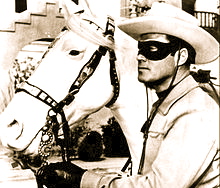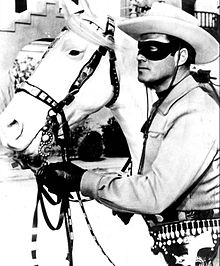Lone Ranger

The Lone Ranger
The Lone Ranger TV Shows from the 1950. This episode about a rancher who is about to be cheated by a gang. They are trying to sell his ranch out from under him by force.
Clayton Moore as the Lone Ranger
The Lone Ranger is a fictional character, a masked ex-Texas Ranger who, with his Native American companion Tonto, fights injustice in the American Old West. The character has become an enduring icon of American culture.
He first appeared in 1933 in a radio show conceived either by WXYZ radio station owner George W. Trendle or by Fran Striker, the show’s writer. The show proved to be a huge hit, and spawned an equally popular television show that ran from 1949 to 1957, as well as comic books and movies. The title character was played on radio by George Seaton, Earle Graser, and most memorably Brace Beemer. To television viewers, Clayton Moore was the Lone Ranger. Tonto was played by, among others, John Todd, Roland Parker, and in the television series, Jay Silverheels.
Departing on his white stallion, Silver, the Lone Ranger would shout, “Hi-yo, Silver! Away!” As they galloped off, someone would ask, “Who was that masked man anyway?” Tonto usually referred to the Lone Ranger as “Ke-mo sah-bee“, meaning “trusty scout” or “trusted friend.” These catchphrases, his trademark silver bullets, and the theme music from the William Tell overture are remembered by the millions who came of age during the decades of the show’s initial popularity or have viewed the television series. Reruns of The Lone Ranger starring Clayton Moore were still being transmitted as of August 2010, sixty-one years after their initial broadcast.
Premise – Lone Ranger
While details differ, the basic story of the origin of the Lone Ranger is the same in most versions of the franchise. Six Texas Rangers are ambushed by a band of outlaws led by Bartholomew “Butch” Cavendish. Later, a Native American named Tonto stumbles on the scene and recognizes the lone survivor, Ranger Reid (whose first name was never given on the show), as the man who had saved his life some time in the past. He nurses Reid back to health. The two men dig six graves for Reid’s comrades, so that Cavendish will think there were no survivors. Among them is Reid’s brother, Captain Daniel Reid, who is the Captain of the Texas Rangers. Tonto fashions a black Domino mask using material from Captain Daniel Reid’s vest to conceal the Lone Ranger’s identity. Even after the Cavendish gang is brought to justice, Reid continues to fight for law and order, against evil and crime under the guise of the Lone Ranger.
Film serials – Main articles: The Lone Ranger (serial) and The Lone Ranger Rides Again
The Lone Ranger serials from Republic Pictures are enigmas to many serial and Lone Ranger fans because they are very rare and hard to find. Only late in 2009 was a complete version of the first serial, in English and with only minor omissions, made available on DVD through the Serial Squadron. Previously, the existing film material for the first serial, The Lone Ranger, was incomplete and either subtitled in Spanish or dubbed in French.
The hero’s identity is unknown even to the audience in the original 1938 serial, with six men suspected of being behind the mask. As the chapters unreel, they are killed off one by one, but each actually appears in the costume in various scenes. (The clichéd plot device of the hero’s or villain’s identity being concealed and multiple candidates being killed off one by one was used in many serials, including Columbia’s Flying G-Men and Republic’s The Masked Marvel, Manhunt of Mystery Island, and Adventures of Captain Marvel.) As the character played by Lee Powell is ultimately revealed to be the Masked Man, that actor is often given sole credit for the part. Two other suspects were played by Bruce Bennett and George Montgomery, then still billed under their respective birth names of Herman Brix and George Letz.
Prior to the serial’s release in 1938, the radio Lone Ranger’s origin had been unknown, and hints had been dropped that he might be a historical figure in disguise. An alternate origin for Tonto, with him being rescued in a mine accident, had also been provided on radio. The 1938 serial presented the first version of the canyon ambush, Tonto nursing the Lone Ranger back to health, and the Lone Ranger swearing vengeance for the first time; all these elements were adopted with minor modifications as the origin of the radio and television versions of the character. Much of the familiar transitional music used in the radio series after 1938 also originated in the first Republic serial.
The second serial, The Lone Ranger Rides Again, was released in 1939 and starred Robert Livingston. It gave the Lone Ranger a second companion, a Mexican named Juan, played by Duncan Renaldo (who later starred as The Cisco Kid on television). Livingston wanted his face to be seen onscreen and consequently appears as rancher “Bill Andrews” in most dialogue scenes. Its standard Western plot concerned a battle over land between outlaws and ranchers. The only known copy of this serial was discovered in South America and was Spanish-subtitled. It had been cut together as a long feature and so is missing most opening titles and original cliffhanger ending resolutions.
George W. Trendle disliked the fact that the Lone Ranger appeared without his mask throughout the serial and consequently decided to terminate Republic’s license to use the character. He then offered the character to Universal Pictures instead. A third Lone Ranger serial was announced in promotional advertising by Universal, but never produced.
Trendle had the prints of both serials destroyed to prevent their further exhibition after the license expired. Some have suggested that Trendle retained prints of the Lone Ranger serials, but made no effort to store them properly, and they deteriorated. However, Clayton Moore notes in his autobiography, I WAS That Masked Man, that he witnessed the master material for the serials being burned on the Republic Pictures back lot. In any case, only Spanish-subtitled foreign dupe prints of the two Lone Ranger serials survive. The Serial Squadron, an organization which restores classic movie serials, painstakingly reconstructed a subtitle-free English digital video version of the serial in 2007, re-creating the original opening titles and restoring the original cliffhangers.
Given all the differences between the two serials, it is perhaps surprising that Tonto was played in both by Victor Daniels, one of two actors known as Chief Thundercloud.
Television series – The Lone Ranger (TV series)
The Lone Ranger was a TV show that aired for eight seasons, from 1949 to 1957, and starred Clayton Moore as the Lone Ranger and Jay Silverheels as Tonto. Only five of the eight seasons had new episodes. It was the ABC television network’s first big hit of the early 1950’s. Moore’s tenure as the Ranger is probably the best-known treatment of the franchise. For the show’s third season, Moore sat out due to a contract dispute and was replaced by John Hart. Moore returned for the final two seasons. The fifth and final season was the only one shot in color. A total of 221 episodes were made.
Moore lawsuits
After the series ended, Moore continued to make public appearances as the Lone Ranger. In 1979, Jack Wrather, then owner of the rights to the character, won a lawsuit against Moore. The actor began wearing oversize wraparound Foster Grant sunglasses instead as a substitute for the mask. Moore later won a countersuit, allowing him to resume his costume.




